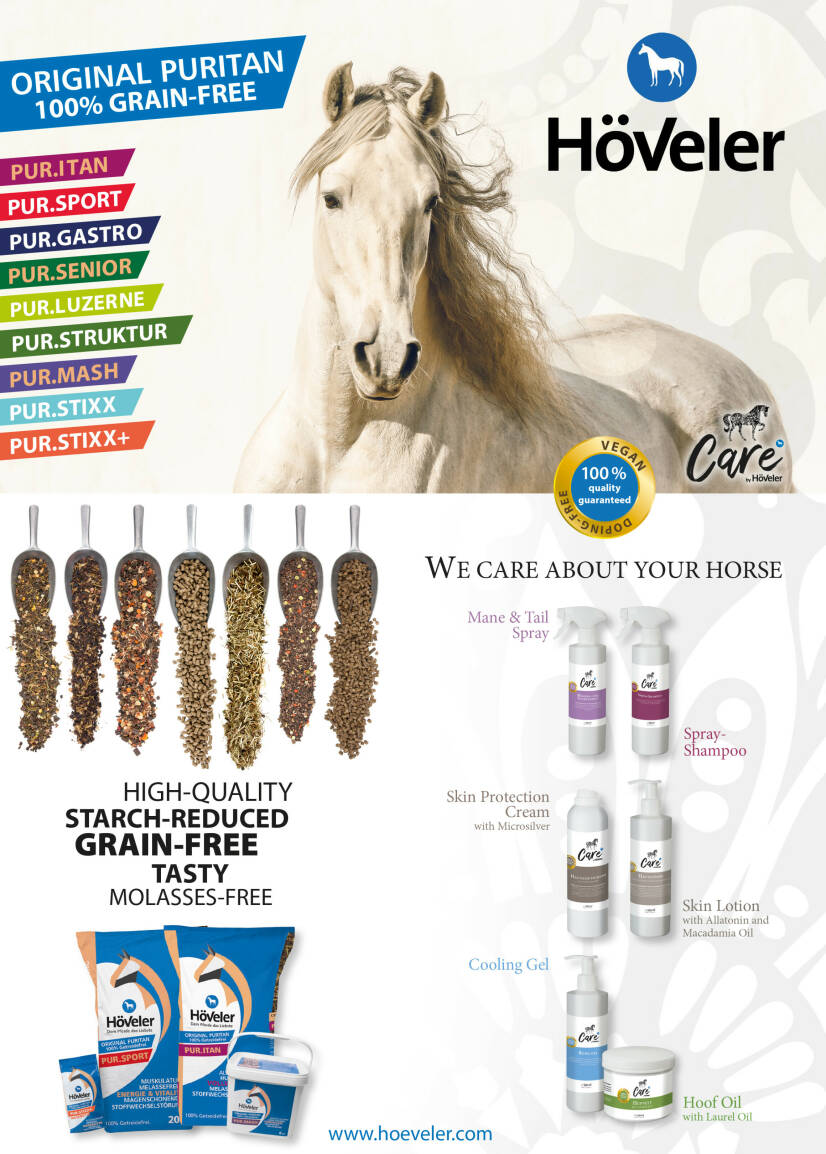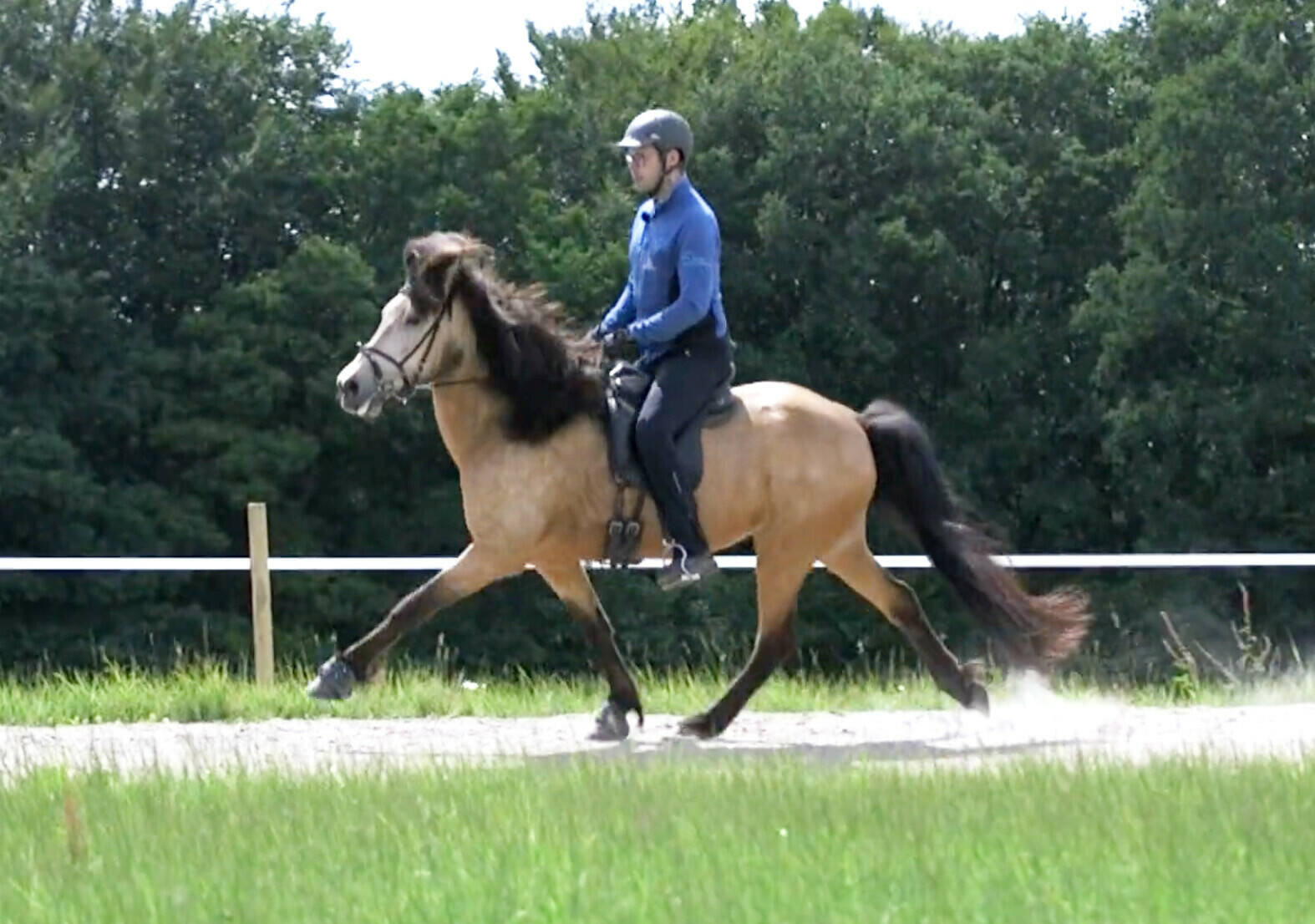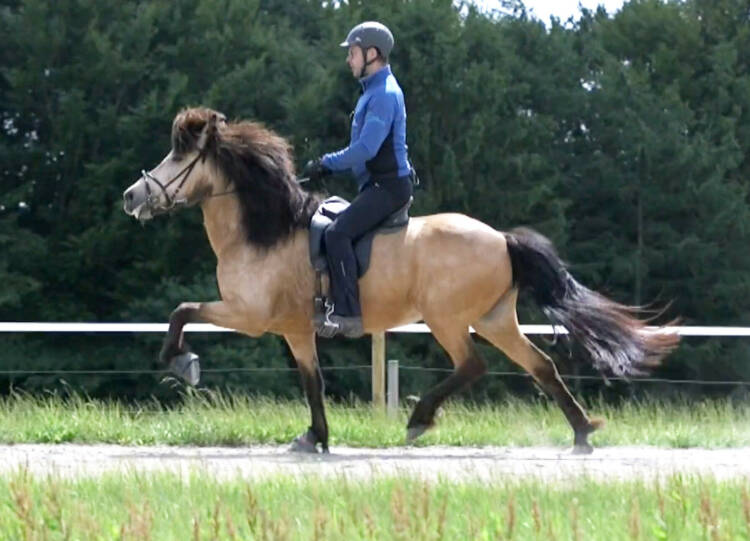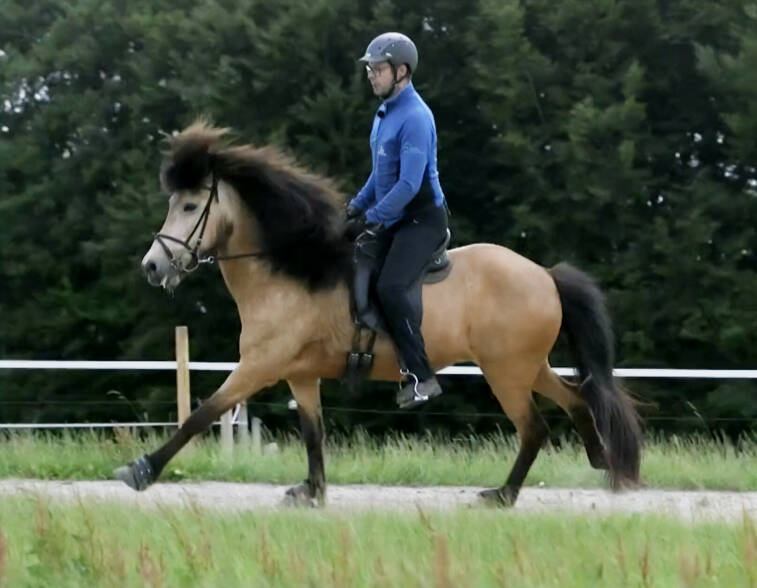




Starting the pace training
Before beginning the pace training, it is, of course, necessary to have control of the basic riding skills. Agnar says: “Of course, those basic things need to be in place before you start riding pace. It is important that the horse understands the reins, a half halt and the pressure from your legs. It is essential to be able to ride the pace at a high speed.” In relation to how Agnar himself starts training pace, he explains: “I do not start by teaching the horse to run pace on an oval track - I do that out on the short gravel road. Our oval track might have 65-70 meters, where we ride pace, but on the gravel road it may only be 20 meters. A short canter (as we teach the horse first), then a transition to pace, and then I say ‘thank you for that’ and slow down again. Then that is what I work from. Then I can always add 20 meters here and 20 meters there. We ride up to 60-70 meters in pace, which is the maximum of what I do in the beginning. Then when it becomes more natural and easy for the horse, it may be up to 150 meters. When we participate in competitions, we have to ride pace for 200 meters, in order to get the high marks. But you do not start with that.”
To separate the gaits
In general, it is important to focus on separating the gaits, when working with Icelandic horses. This can also be a challenge in the pace. Sometimes the horses tend to go into a cross-canter if the pace becomes too two-beat, whereas the horse might fall into a canter if the pace becomes too four-beated. Therefore, it is important to find a balance between the pace going neither too two-beat nor too four-beat - where the horse thus runs a correct pace.One of the things that can cause the horse to fall into the cross canter is if it lays too hard on the rein, as this can cause the horse to be too much on the front legs and therefore fall into a cross canter. To avoid this, Agnar explains: “When we ride the horse forward in the pace, it is important that the horse toes not rely too much on the reins and fall onto its front. Therefore, we try to have a little bit of vibration in the rein, to get the horse up and stretched forward instead.” Agnar also explains that there are ways to help with the horse’s balance. For example, you can use your own weight to support the horse’s balance, while at the same time having the opportunity to use boots on the horse. He says: “In Icelandic sports competitions, we may use plastic or silicone soles in the front hooves or boots (up to 250g). If you have a horse, that is too two-beated in the pace, it may be a good idea to put a little more weight on the front legs, like this.”
Pace is just like the taste of strawberries
Pace is not particularly easy, and therefore it is encouraged, that if you have never tried riding pace before, you should seek some help and try it out on a trined horse, before trying to teach an untrained horse. According to Agnar, pace is also not easy to describe, and he says: “Teaching people to ride pace is a bit like having to explain the taste of strawberries. Strawberries just taste like strawberries. And in order to ride pace, you just have to ride pace. The only way to learn it is by trying it. And practice. If you need to think about the order in which the correlations should come in, then it is too late. So the only way to become good at riding pace, is to just try and practice. And again - it’s better to ride a shorter distance and in a low speed in the beginning.”


When training pace, it is essential that the horse stretch and look forward, as it is about getting the horse to lift itself off the ground and getting these hovering moments, where none of the horse’s legs touch the ground.
In order to get the horse into the pace, Agnar explains how he does it: “If I ride with the inside rein being on the right, then I will ride the horse into a right canter lead. Then I keep the outer rein (the left) stable. When we turn out of a corner, I move my bodyweight (upper body) a little bit outwords - in this case to the left - while I pull a little bit on the inner (right) rein and in that way interrupt the right shoulder a bit by making a small half halt. In this way, you make the horse understand that it must stop the rolling canter movement, and instead get into the pace. Once this is done, I just encourage it to keep going.”
You almost always transition to pace from canter, and this is what Agnar prefers, as it helps to separate the gait. However, it is possible to do the transition from both tölt and trot. In transitioning, you can also use your upper body and thus reduce the need for using the reins. Agnar explains: “I move my upper body a little outwards, just to move the weight a little and take some of the balance away from the canter. In this way, I need less impact from the rein, and in most cases, I get the horse to stop the canter movement. When I feel that the horse has started to find the beat in the pace, I correct the horse again, as it is difficult - and almost impossible - for a horse to run pace with a bent neck. So then I make the horse straight, move my hand forward and try to encourage the horse to go towards the rein.”
Pace without any stress
Some horses tend to get a little stressed, when training the pace. But this can be avoided - if we take our precautions. The stress can be caused by different things, like for instance, if you have started the training too soon, or if you ride too fast. These things can contribute to the horses getting stressed. Therefore, Agnar emphasizes the importance of taking your time, when you want to introduce your horse to pace. He believes that you should only train it in short intervals, so that the horse does not get too long distances or too much speed in the beginning. Agnar elaborates: “Of course you should not ride the pace all the time, but there is nothing wrong with training it just like you train other gaits. It is just important to remember, that pace is just like racing - the horses run at very high speed.”
Short intervals
Since pace is a gait that requires a lot of energy and strength from the horse, one must be careful not to ride it for too long at a time. Agnar explains: “If you ride pace every time you and your horse ride in nature, and you do it so that it is hard for the horse, and it gets lactic acid, and you keep pushing it, then this will of course become a stressful moment for the horse. I think it is more natural to start slowly and teach the horse to stretch and run towards the reins - then just do it in small intervals in the beginning. You do not really ride pace over long distances.” In addition, it can also be beneficial if you place the pace training in the middle of your training session. In this way, the horse is warmed up, but is not too tired. Agnar does this too, and he believes it makes the pace training a more natural part of the training. He also focuses on the fact that it must be fun and feel good for the horse, and Agnar says: “You want a horse that is relaxed in the gait, and thinks that it is fun. Because it really is a lot of fun. Especially for the rider.”
By Line Holm Rasmussen // Photo: Rid Bedre TV // Sources: Rid Bedre TV with Agnar Snorri Stefánsson
Agnar Snorri Stefánsson is an internationally acknowledged trainer and rider. He was born and raised in Iceland, and grew up around Icelandic horses. He took an education at Hólar university and is now a trainer and riding instructor. He now lives in Denmark with his family and he owns the stable Stald Gavnholt, which holds around a hundred Icelandic horses. He has collected titles such as Icelandic Champion and Nordic Champion several times and has participated in finals in both the European Championships, World Cup and Landsmót. This has contributed in making him one of the most wanted riders at the big international awards - which has led him to triumph with four world champions.
Some Icelandic horses are five-gaited, which means that they can walk, trot, tólt, canter and pace. Pace is a gait with a lot of speed. Pace is a two-beat gait in which both legs on one side of the horse simultaneously touch the ground. This movement means that in the time between the right and left side, there is a hovering phase where none of the horse’s legs touch the ground.

AGNAR SNORRI STEFÁNSSON


Snorri Stefánsson





Starting the pace training
Before beginning the pace training, it is, of course, necessary to have control of the basic riding skills. Agnar says: “Of course, those basic things need to be in place before you start riding pace. It is important that the horse understands the reins, a half halt and the pressure from your legs. It is essential to be able to ride the pace at a high speed.” In relation to how Agnar himself starts training pace, he explains: “I do not start by teaching the horse to run pace on an oval track - I do that out on the short gravel road. Our oval track might have 65-70 meters, where we ride pace, but on the gravel road it may only be 20 meters. A short canter (as we teach the horse first), then a transition to pace, and then I say ‘thank you for that’ and slow down again. Then that is what I work from. Then I can always add 20 meters here and 20 meters there. We ride up to 60-70 meters in pace, which is the maximum of what I do in the beginning. Then when it becomes more natural and easy for the horse, it may be up to 150 meters. When we participate in competitions, we have to ride pace for 200 meters, in order to get the high marks. But you do not start with that.”
To separate the gaits
In general, it is important to focus on separating the gaits, when working with Icelandic horses. This can also be a challenge in the pace. Sometimes the horses tend to go into a cross-canter if the pace becomes too two-beat, whereas the horse might fall into a canter if the pace becomes too four-beated. Therefore, it is important to find a balance between the pace going neither too two-beat nor too four-beat - where the horse thus runs a correct pace.One of the things that can cause the horse to fall into the cross canter is if it lays too hard on the rein, as this can cause the horse to be too much on the front legs and therefore fall into a cross canter. To avoid this, Agnar explains: “When we ride the horse forward in the pace, it is important that the horse toes not rely too much on the reins and fall onto its front. Therefore, we try to have a little bit of vibration in the rein, to get the horse up and stretched forward instead.” Agnar also explains that there are ways to help with the horse’s balance. For example, you can use your own weight to support the horse’s balance, while at the same time having the opportunity to use boots on the horse. He says: “In Icelandic sports competitions, we may use plastic or silicone soles in the front hooves or boots (up to 250g). If you have a horse, that is too two-beated in the pace, it may be a good idea to put a little more weight on the front legs, like this.”
Pace is just like the taste of strawberries
Pace is not particularly easy, and therefore it is encouraged, that if you have never tried riding pace before, you should seek some help and try it out on a trined horse, before trying to teach an untrained horse. According to Agnar, pace is also not easy to describe, and he says: “Teaching people to ride pace is a bit like having to explain the taste of strawberries. Strawberries just taste like strawberries. And in order to ride pace, you just have to ride pace. The only way to learn it is by trying it. And practice. If you need to think about the order in which the correlations should come in, then it is too late. So the only way to become good at riding pace, is to just try and practice. And again - it’s better to ride a shorter distance and in a low speed in the beginning.”


When training pace, it is essential that the horse stretch and look forward, as it is about getting the horse to lift itself off the ground and getting these hovering moments, where none of the horse’s legs touch the ground.
In order to get the horse into the pace, Agnar explains how he does it: “If I ride with the inside rein being on the right, then I will ride the horse into a right canter lead. Then I keep the outer rein (the left) stable. When we turn out of a corner, I move my bodyweight (upper body) a little bit outwords - in this case to the left - while I pull a little bit on the inner (right) rein and in that way interrupt the right shoulder a bit by making a small half halt. In this way, you make the horse understand that it must stop the rolling canter movement, and instead get into the pace. Once this is done, I just encourage it to keep going.”
You almost always transition to pace from canter, and this is what Agnar prefers, as it helps to separate the gait. However, it is possible to do the transition from both tölt and trot. In transitioning, you can also use your upper body and thus reduce the need for using the reins. Agnar explains: “I move my upper body a little outwards, just to move the weight a little and take some of the balance away from the canter. In this way, I need less impact from the rein, and in most cases, I get the horse to stop the canter movement. When I feel that the horse has started to find the beat in the pace, I correct the horse again, as it is difficult - and almost impossible - for a horse to run pace with a bent neck. So then I make the horse straight, move my hand forward and try to encourage the horse to go towards the rein.”
Pace without any stress
Some horses tend to get a little stressed, when training the pace. But this can be avoided - if we take our precautions. The stress can be caused by different things, like for instance, if you have started the training too soon, or if you ride too fast. These things can contribute to the horses getting stressed. Therefore, Agnar emphasizes the importance of taking your time, when you want to introduce your horse to pace. He believes that you should only train it in short intervals, so that the horse does not get too long distances or too much speed in the beginning. Agnar elaborates: “Of course you should not ride the pace all the time, but there is nothing wrong with training it just like you train other gaits. It is just important to remember, that pace is just like racing - the horses run at very high speed.”
Short intervals
Since pace is a gait that requires a lot of energy and strength from the horse, one must be careful not to ride it for too long at a time. Agnar explains: “If you ride pace every time you and your horse ride in nature, and you do it so that it is hard for the horse, and it gets lactic acid, and you keep pushing it, then this will of course become a stressful moment for the horse. I think it is more natural to start slowly and teach the horse to stretch and run towards the reins - then just do it in small intervals in the beginning. You do not really ride pace over long distances.” In addition, it can also be beneficial if you place the pace training in the middle of your training session. In this way, the horse is warmed up, but is not too tired. Agnar does this too, and he believes it makes the pace training a more natural part of the training. He also focuses on the fact that it must be fun and feel good for the horse, and Agnar says: “You want a horse that is relaxed in the gait, and thinks that it is fun. Because it really is a lot of fun. Especially for the rider.”
Agnar Snorri Stefánsson is an internationally acknowledged trainer and rider. He was born and raised in Iceland, and grew up around Icelandic horses. He took an education at Hólar university and is now a trainer and riding instructor. He now lives in Denmark with his family and he owns the stable Stald Gavnholt, which holds around a hundred Icelandic horses. He has collected titles such as Icelandic Champion and Nordic Champion several times and has participated in finals in both the European Championships, World Cup and Landsmót. This has contributed in making him one of the most wanted riders at the big international awards - which has led him to triumph with four world champions.
By Line Holm Rasmussen // Photo: Rid Bedre TV // Sources: Rid Bedre TV with Agnar Snorri Stefánsson
Some Icelandic horses are five-gaited, which means that they can walk, trot, tólt, canter and pace. Pace is a gait with a lot of speed. Pace is a two-beat gait in which both legs on one side of the horse simultaneously touch the ground. This movement means that in the time between the right and left side, there is a hovering phase where none of the horse’s legs touch the ground.


